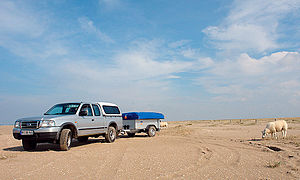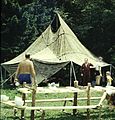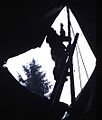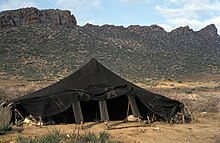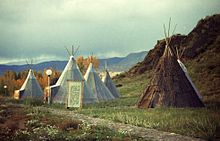List of tent types
This list of tent types provides information about different types of tents .
Tents for trekking and similar activities
Modern tents weigh less than 1,500 grams per person; In the case of larger trekking tents for several people, the weight can sometimes be 800 grams per person. This weight reduction was achieved by replacing aluminum or wooden poles with special metal alloys or fiberglass. In the course of time, cotton was also replaced as tent material by nylon or polyester .
The tents differ mainly in their construction, which in turn is determined by the respective requirement profile:
- Dome tent: stable in wind and snow, easy to set up, most common type for pure camping.
- geodesic tent: very stable in wind and snow, slightly heavier than dome tents.
- Tunnel tent: very light, plenty of space for luggage and equipment.
- Ridge tent: little wind stability, high weight (if cotton is used as tent material), but easy to improvise.
A tent that has an inner tent inside the actual tarpaulin offers more comfort . The water vapor generated by breathing and sweating condenses on the inside of the "outer tent". In order to dissipate the water vapor, outer tents should be ventilated and the inner tent still offers wind protection. If you bump into the inner tent wall, you won't come into contact with the condensation water, and at night there are no outlines on the outer tent when it is illuminated.
Depending on the type of transport (on foot, bike, car), region (mountains with snowfall and wind, forest and lowland with little wind), number of people and amount of luggage, the different types of tents are more or less suitable: Alpinists tend to choose geodetic tents, trekking travelers rather tunnel tents, while as a driver you can easily use a heavy, old cotton tent. Comfort can also play a role: Tunnel tents in particular have a large apse (covered space outside the inner tent) so that you can cook in the tent in bad weather. Ultimately, the material quality can be a criterion, although this property varies more between manufacturers than between tent types.
Dome or igloo tent
A dome tent or igloo tent is a modern type of tent ( lightweight tent ) in which the frame spans an inner tent in two arches diagonally across the base. These tents are free-standing, as the poles stretch the tent, they can also be set up without tent pegs or pegs if necessary , provided that enough weight (luggage) can protect the tent against the wind .
This type of construction offers better protection against mechanical stress (snow, wind) than tunnel tents , but is not as stable as geodetic constructions . However, these are also heavier due to the higher number of pole arches.
Pop up tent
More recent developments are so-called throw or seconds tents. The poles are designed in a ring shape and are connected directly to the tent skin. When packed, the tents are folded flat to form a disc by twisting the fiberglass rings in half. It is then set up simply by loosening the transport bracing and throwing the tent up. The spring force of the fiberglass rings unfolds the tent so that it stands by itself. The advantage is the time saved when setting up, the disadvantage is the large pack size (diameter of the folded tent about 60 to 80 centimeters). The fiberglass rings are softer than normal elastic rods and folding them into a disc shape can take longer than the time saved during assembly without practice.
Tunnel tent
A tunnel tent is called a modern lightweight tent with several parallel pole arches . This type of tent absolutely requires pegs to stand and is less stable against wind in the transverse direction than a dome tent or a geodetic construction. The advantage of the tunnel tent is the low weight and the favorable use of the interior space due to the steep walls.
Geodesic
A geodesic is a lightweight tent that builds a hemispherical tent with three or more pole arches over the base area. If necessary , this type of tent can also stand without pegs (provided there is enough weight in the tent against the wind) and, if well braced, is considered particularly storm-proof. Storm security comes from the crossing points of the tent poles: A geodesic has more crossing points than tent poles. The connection with geodesy is given by the so-called geodetic line , the shortest connection between two points on an arbitrarily curved surface.
Ridge tent
The ridge tent is a very old type of tent and basically consists of two vertical tent poles, a tarpaulin, guy ropes and pegs . The tarpaulin is stretched in such a way that a roof ridge forms and the tent has a triangular shape when viewed from the front. Some models also have a horizontal tent pole. The roof ridge no longer sags and the load is shifted from the tent cords to the tent poles, which makes the tent more robust.
The advantage of the ridge tent is the simple construction with few materials, but because the tent roof leads away from the ground at a 45 ° angle, the interior space is poorly used compared to dome or tunnel tents. The wind stability is also lower compared to other types of tent. Due to the simple geometry of the tarpaulin, it is possible to divide the tent components into the luggage of several people in larger tents. Double-walled ridge tents are still popular with boy scouts as group tents, for some years now very light, single-walled ridge tents have been on the market as bivouacs (e.g. "Rajd" from Hilleberg ).
Prahmzelt
The shape of a pram tent is reminiscent of a half-opened ball-paper lampion or the folding roof of an old convertible vintage car, the poles form semicircles that are braced with spacer bars. Prame tents are mainly offered as a piece of equipment for carp anglers (and then called "bivvy"). Your advantages are quick assembly (the rod parts are permanently threaded), stable aluminum rods, high rain and wind stability, partly steep walls and an elongated or (standing) high shape. The groundsheet is usually made very robust because carp anglers usually set up carp beds with high point loads in the tents. The disadvantage is that they are usually heavy, as they are not built for hikers. Carp anglers also use half tents at the hide (called “brolly”, “fishing umbrella ”, “shelter” ), which are constructed like an umbrella or a tent shell .
Beach shelter
A tent shell or beach shell is a half-open tent that is usually only supported by a pole stretched in a semicircle. More complex models can be sealed watertight at the front if necessary. Beach shells are mainly used to protect against wind, rain and sun; only larger versions can be used for the night.
Single arch tent
Single- arch tents are built similar to tent shells , but they are closed on all sides.
Tarp
A tarp (from Tarpaulin ) is a mostly rectangular, square or trapezoidal tent sheet that is simply laid over a cord (stretched between two trees or stretched from a tree to the ground) and anchored at the corners directly to the ground or anchored to the ground. Alternatively, you can use trekking poles or branches as tent poles. The tarp is particularly popular with ultra-light hikers. Its disadvantage is that you are exposed to changing winds and insects due to the open structure.
Bivouac tent
The bivouac tent is a special form of tent. It is a hybrid of a bivouac sack and a tent. The body area is covered by a bivouac sack that turns into a small tent above the head area. The bivouac tent consists of little fabric and very few poles. This design ensures an extremely light weight, with a little more comfort than a pure bivouac sack.
Inflatable tent
There are two types of inflatable tents. Light hiking tents (in geodesic form) without poles are straightened by inflated air chambers instead of poles. Cantilevered large tents are maintained in that the air body of the interior is constantly maintained in the volume by blowing in air.
- With the inflatable “Swiss IGLOO” dome tents, the usual two crossing tent poles are replaced by inflatable “fire hoses”. Thanks to the high-quality and well-dimensioned materials, these tents have an exceptionally good and stable stand.
- The production of the company "SIKON AG" in the Swiss Uster was stopped years ago.
Tents after further use
Marquee
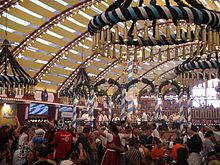
A festival tent , also known as a beer tent , is a tent or tent-like building that can be easily dismantled, in which, for example, a restaurant with an entertainment program is housed at folk festivals and similar events and / or in which a party takes place. Depending on the type of event to enter can a marquee entry costs or even be free. As a rule, however, no entrance fee is charged.
Industrial tent
An industrial tent is a lightweight hall construction that is used as a warehouse or as a temporary assembly hall. Since industrial tents are usually used as warehouse extensions, they are often referred to as storage tents . In modern logistics , temporary industrial tents play an economically important role, especially for industrial and shipping companies, due to the low construction costs.
Party tent
A party tent is the smaller and more private form of the marquee . It can protect an outdoor celebration from rain, wind, and solar radiation.
Rescue, refugee, emergency tent
A rescue or emergency tent is a tent for people in need who receive help there and / or are given the opportunity to sleep there. An example of this are refugee tents or crisis tents for evacuations due to disasters. SG tents of various sizes are used in particular in disaster control and fire services. Here they are used as kitchen tents , medical tents , accommodation tents or the like, unless a suitable structural object is available.
Medical tent
A medical tent is a tent for the temporary accommodation and treatment of patients . It is part of a treatment center or a field hospital . Medical tents are used in the military or for humanitarian aid as well as in the event of mass casualties or as part of planned medical watch services at events.
Mirror tent

A mirror tent (Flemish: mirrored), also called the mirror palace, is a transportable event hall made of wood and canvas , which is reminiscent of a circus tent in terms of shape and mobility . The original place of origin of the mirror tents is Belgium.
Big top
The circus tent (also Chapiteau , from French chapiteau = capital ) is usually a tent with a round or oval floor plan. It serves the traveling circus as a venue for its performances. The technology for transportable tents of this size has only been around since the end of the 19th century. Previously, circus performances took place in permanent theater buildings such as the Cirque Olympique or in show booths .
Vehicle tents
- A car roof tent is permanently mounted on the roof of a vehicle and can be packed into a compact package like a roof rack for the journey . The tent that is set up is essentially available in two designs: tents that form a sleeping cabin on the roof of the car and those that also create living space next to or behind the vehicle.
- A car awning is - similar to an awning - a roof stretched out by a van with two tent supports that are stretched down with cords.
- A tent trailer or folding caravan can be folded out or down from a trailer, creating a large bedroom and living room. Combined with an awning, room dimensions of up to 30 m² can be achieved. Due to the low weight of up to 300 kg, the trailer can also be pulled by small cars, depending on the product, payloads of up to 700 kg are possible. The tents are made of strong cotton or mixed fabrics and are supported by a steel or aluminum tubular frame. Cotton liners are used in tents that do not have a permanently integrated floor to reduce condensation. In contrast to steep wall tents, there is a high level of storm security due to the design. Advantages compared to caravans are low maintenance costs and better driving behavior thanks to compact dimensions when closed and a low center of gravity.
- A covered wagon is ultimately a laid on a horse-drawn wagon mounted tent in tunnel form.
Military tents
Ancient Rome
- A tentorium ( Latin , from tendo "to span") was a tent in Roman antiquity , especially in the Roman military .
- The tabernaculum was a tent , mostly an officer's tent in Roman antiquity , in particular used by the Roman military .
Military tents (Switzerland)
Swiss military tents are made from square waterproof cloths, so-called military sheets and tent pole units each made up of a three-part tent pole and three pegs. The military and youth organizations in particular ( Boy Scouts , Jungschar , Cevi , Jungwacht Blauring ) often use these types of tents for camps and hikes. Since the tarpaulins can be connected to each other in a variety of ways, different types of tents can be set up.
coffin
The two adjacent sides of a sheet are connected to each other, creating a bag. The longest extension of the bag becomes the sloping ridge of the tent. To set it up you need three pegs, a tent stick and a string. The open head end can be closed with a backpack, for example. The "coffin" serves as an emergency bivouac for a single person.
Donut
The Berliner is a type of tent that is mainly used as an emergency bivouac. The name for this tent is Berliner, because its shape and structure are reminiscent of a Berliner .
To build this tent you need the following utensils:
- 8 military sheets
- 4 tent pole units
- 4 tent cords.
Four panels are put together to form a square. Place the two squares on top of each other and rotate the upper one by 45 °. The two squares are then connected together. Then four tent poles (for the four corners) and a longer tent pole (for the middle of the Berliner) as well as tent cords are required to set up the tent.
The advantage of the Berliner is its waterproof floor and good thermal insulation. It offers space for four to five people with luggage. In an emergency, up to eight children can find shelter in it. A disadvantage is the high cost of materials per person and that it can get very hot inside the tent in strong sunshine. But this can also be used to build an improvised sauna using hot stones.
Gotthard
The Gotthard is a type of tent that is mainly used for bivouacs at high altitudes.
The tent got its name because of its very flat shape. In it you almost feel as if you are sitting in a tunnel .
To build this tent you need the following utensils:
- 3 military sheets
- 2 tent pole units
- 4 tent cords.
This tent is especially useful if you have to bivouack - the material consists of only three tent sheets that you have to take with you. The advantage of the Gotthard is its small surface area and low weight. But it offers little space. If you have two more military sheets available, you can close the outer walls, which increases the thermal insulation considerably. Otherwise the tent must be set up across the wind or the entrances that are open on both sides must be closed with rucksacks or other material.
Sarasani
The Sarasani is a pyramid-shaped large group tent . It is buttoned from three tarpaulin squares that are hung on a pole or a rope. The corners are stretched outwards and anchored. The name is reminiscent of the German Sarrasani circus .
The Sarasani is often used as the central meeting and dining tent in youth camps and often serves as a landmark. The tent can be made larger by using more tarpaulins and a taller mast. A rare occurrence are 696 tarpaulins with a 24 meter high mast (2006 Pfadi Neuburg / Wartensee from Winterthur ).

| Tarpaulin | 12 | 27 | 48 | 75 | 108 |
|---|---|---|---|---|---|
| Edge | 5 | 6.6 | 8.2 | 9.9 | 11.6 m |
| diagonal | 7.1 | 9.4 | 11.6 | 14th | 16.4 m |
| surface | 33 | 74 | 131 | 204 | 294 m² |
| height | 2.2 | 3.3 | 4.4 | 5.5 | 6.6 m |
(The height of the poles, which create the distance between the lower edge and the ground, must be added to the height, the central pole is usually around 2.5 m longer)
The construction is associated with great effort and material and requires a lot of experience in pioneering technology.
For a Sarasani you need:
- depending on size 12, 27, 48 or 75 panels (3 times n²)
- 1 central post (tree trunk) with a height of about 7 meters, depending on the number of military
tarpaulins used , the Sarasani can be hung on a rope stretched between two trees - 1 pulley to pull up
- 1 rope (to pull up)
- 6 shorter ropes for tensioning
- 6 stakes for tensioning
- 6 poles as the distance between the lower edge of the tent and the ground
- 3 longer ropes as support on the edges
A large Sarasani is very heavy (dry with 75 sheets already 100 kg, in rain and wind significantly heavier). Even low wind speeds develop high forces. At corners, the ropes are therefore not attached to the eyelets, but rather with a parallel collar to prevent the eyelets from tearing out. To relieve the buttons and corners, three ropes have also proven to be useful, each stretched from the tip under the diagonal of the three tarpaulin squares to the corners of the Sarasani, and in the case of large tents also under the edges, outwards. A 12 Sarasani can usually be hung on the corner eyelets of the tarpaulin. If you use the same procedure, you have to expect the corner eyelets to tear out on a 27. This can be prevented by connecting the tarpaulin directly to the rope instead of the eyelets.
The tarpaulins are buttoned on top of each other like roof tiles away from the main direction of rain so that the rainwater runs off. A tarpaulin in the top is often designed as a smoke opening facing away from the wind, which can be closed with a cable pull from below. A fireplace or a kitchen can also be set up in the Sarasani.
Nomad tent shapes
Nomadic peoples developed tents made of animal skins or fabric at an early stage and developed special designs.
Teepee shape
Tipi is the name for a tent of the North American Indians , where tent fabric is stretched over tent poles that are put together to form a cone. See also Kohte (ado-it-yourself tent, originally used by the nomads of Lapland ), and Tschum .
Yurt shape
The yurt is the traditional tent of the nomads in West and Central Asia .
Berber tent
A Berber tent ( Arabic , DMG al-Ḫaima ), Khaima, Haima or Chaima is the traditional dwelling of the Berbers - nomads in the south of the Maghreb countries of Morocco , Algeria , Tunisia and Libya . They probably existed before the first permanent settlements with houses made of rammed earth and stone.
Bedouin tent shape
Arab tents ( Chaima ) or Bedouin tents , caidal (and king tents ) are mostly steep wall tents, reminiscent of a circus tent. Since it rarely rains in the deserts or a rare rain is to be caught, the roof slopes are designed to sag.
Kote

The term Kote is used in the German-speaking area as a collective term for all traditional dwellings of the northern European ethnic group of the Sami - both for the stationary huts and for mobile tents.
Black tent
The traditional portable dwelling of many nomadic peoples is called the black tent . For over 5000 years the black tent has been used in Northwest Africa, Arabia, Persia and Tibet. The origin of the black tent is believed to be in the Arab region, other theories suggest a Persian origin near Baluchistan .
Tschum
The Tschum , also Spitz yurt , is a traditional dwelling of the Khanty , Mansi and Nenets in the West Siberian lowlands and other peoples of Siberia . It consists of a frame made of wood - mostly Siberian stone pine or birch - and is covered with fur or fabric, originally also with birch bark. Thus it is similar to the tipi from North America or the Lávvu of the northern European Sami .
See also
Web links
Individual evidence
- ↑ rotatable 360 ° image ( memento of the original from October 26, 2012 in the Internet Archive ) Info: The archive link was inserted automatically and has not yet been checked. Please check the original and archive link according to the instructions and then remove this notice.
- ↑ Parallel union in Scoutwiki
- ↑ Tent made from goat hair









